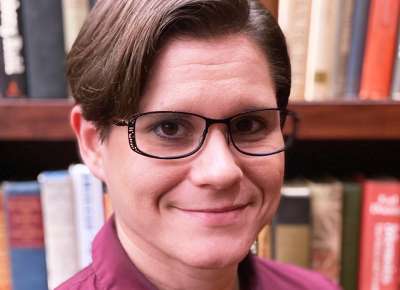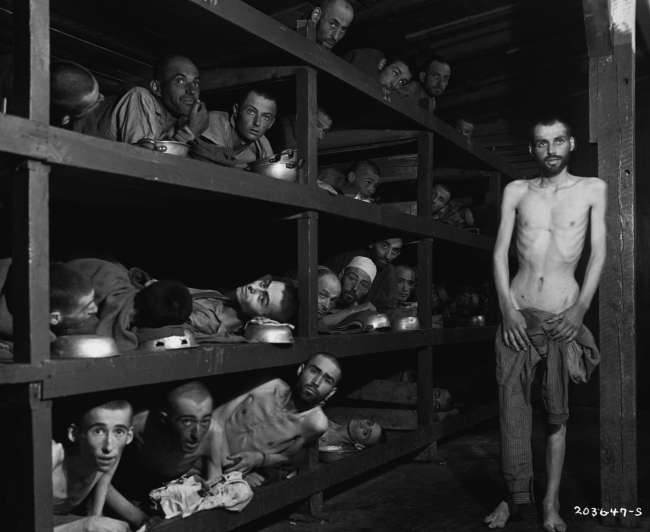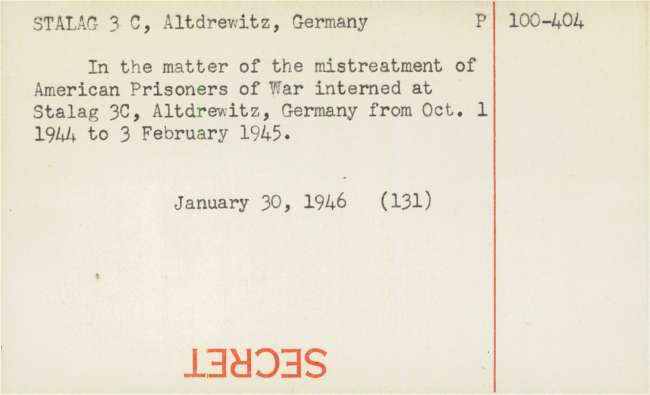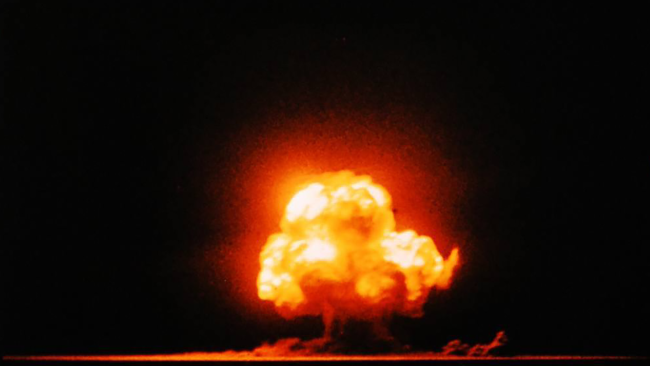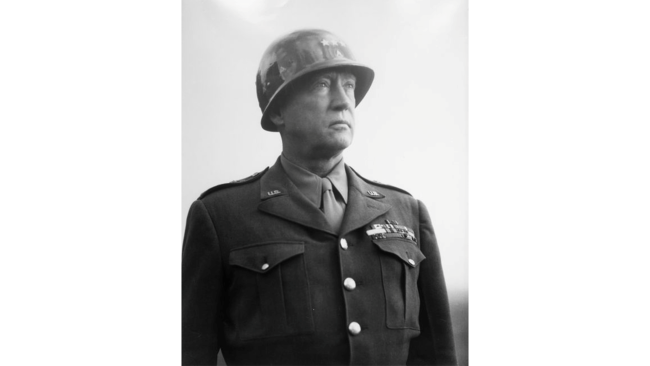Top Image: Nazi defendants sitting in the dock during the Nuremberg Trials. National Archives and Records Administration, 540128.
With World War II at its end, a central question remained for the victorious Allied powers: how to hold Axis leaders accountable for their actions. The answer of the Allied powers to this question established a precedent that continues to influence international justice to this day. Leaders of the Allied forces knew that the scale and nature of war crimes that occurred in both the European and Pacific theaters of the war demanded a response that would both serve justice and help prevent such atrocities from occurring in the future. The decision to place the surviving Nazi and Japanese officials on trial, presided over by international military tribunals, established a new precedent in the enforcement of international law and forever changed the meaning of justice in a postwar world.
Allied leaders knew that placing Axis leaders on trial presented a difficult situation, as many saw the actions taken to punish Germany following World War I as contributing to Adolf Hitler’s rise to power prior to World War II. Building on an idea that emerged in 1943, a detailed approach of how to bring Nazi leaders to justice took shape at the Yalta Conference in February 1945. Although British Prime Minister Winston Churchill favored the idea of summary executions, the two other Allied leaders, Franklin D. Roosevelt and Joseph Stalin, overruled this option. Instead, the Yalta Conference established the path for placing leading Nazi officials on trial because their actions, the Yalta agreement noted, “[did] not consist solely of individual outrages, but [represented] the result of a systematic and planned reign of terror…” The agreement outlined that German leaders especially, but also lower ranking associates, would face justice for their “atrocious crimes” and “joint participation in a broad criminal enterprise…”
Plans would evolve further at the Potsdam Conference from July 17 to August 2 1945. This Conference featured a notable change for the United States as Harry Truman assumed the office of President following Franklin Roosevelt’s death on April 12, 1945. In addition to outlining the conditions of Germany’s surrender, the leaders of the Allied powers determined that a trial of major war criminals should occur soon after the war’s end. As part of the Potsdam Agreement, the Allies decided to place the surviving Nazi leaders on trial for their crimes. However, a question still remained—what charges would these men face?
The end of World War II created an altogether unprecedented situation for world leaders and people across the globe. News of Nazi atrocities resulted in the creation of a new crime, crimes against humanity. While the phrase had existed since the early nineteenth century, it was only after World War II that any military or political leader had been put on trial for such a crime. Article 6 of the Charter of the International Military Tribunal (IMT), which established the judicial body to oversee the trials against indicted Nazi leaders, defined “crimes against humanity” as including “murder, extermination, enslavement, deportation, and other inhumane acts committed against any civilian population, before or during the war…” The definition also encompassed persecutions carried out for political, racial, and religious reasons. In this agreement, the United States, Great Britain, the Soviet Union, and France outlined the means of prosecuting and punishing those found guilty of committing crimes against humanity. The scale of Nazi crimes also led to the creation of a new term—genocide—coined by Raphael Lemkin, a Polish-Jewish lawyer. While not a legal term, genocide did appear in the indictment issued by the IMT charging Nazi officials for their brutal efforts to exterminate all deemed “unfit” to remain within German society.
Beginning on November 20, 1945, 22 Nazi officials were brought to trial in the city of Nuremberg in Germany. The location of Nuremberg held symbolic meaning, as the city long served as a base of Nazi power. Life writer Sidney Olson reported in an article printed May 14, 1945, that
“Nürnberg, once a city symbolizing German culture, then Hitler’s symbol of Nazi Kultur, is now no symbol of anything. Today Nürnberg looks like all the rest of the shells of cities, a great waste of broken bricks.”
Sidney Olson, Life
While roughly 200 Nazi leaders faced charges in the Nuremberg Trials, the trial of the 22 leading Nazi officials featured prominently in American newspapers and magazines, turning the trial into an international spectacle. Several of the Nazis on trial unsuccessfully attempted to cite Befehlsnotstand, a German legal idea that one was exempt from justice if they committed the acts under orders.
Presided over by judges from the four Allied powers and headed by Chief Prosecutor and US Supreme Court Justice Robert Jackson, the Nuremberg Trials changed the enforcement of justice across the globe forever. As noted in Justice Jackson’s Final Report to President Harry Truman, the trial lasted 216 days and included examination of over 100,000 German documents, over 25,000 photographs, and extensive film footage of Nazi atrocities. Altogether, the transcript of the trial was over 17,000 pages in length. By the trial’s end, 12 Nazi leaders were sentenced to death, three were sentenced to life imprisonment, and four were sentenced to prison for a period of 10-20 years, with three being acquitted. The executions occurred on October 16, 1946, although the highest ranking Nazi official tried, Hermann Goering, committed suicide in his cell hours before the scheduled time of his execution.
Tokyo War Crimes Trial
The trials held in Nuremberg became the model for the trials that followed in Tokyo. Ordered on January 19, 1946, by General Douglas MacArthur, the Supreme Commander of the Allied Powers (SCAP), the International Military Tribunal for the Far East (IMTFE) convened on April 29, 1946, to put leaders from the Empire of Japan on trial for joint charges of conspiracy to start and wage war. Additional judges from countries outside of the Allied Powers presided over this trial in response to criticism charging the Allies with enforcing a “victor’s justice” over the defeated Axis powers at Nuremberg. Still, the United States initiated the arrests of 28 Japanese leaders and led the subsequent trials from May 3, 1946, to November 12, 1948. Arrested Japanese leaders faced charges of war crimes, crimes committed against prisoners of war, and crimes against humanity.
The decision to prevent Japanese Emperor Hirohito from going on trial was a part of the negotiations with Truman at Potsdam, and it affected the nature of the Tokyo Trial from the start. Both SCAP and Japanese officials worked to ensure no testimony implicated the Emperor, and MacArthur went further, calling for the censorship of numerous topics in Japanese media that included any criticism directed toward the Imperial government or against SCAP itself. Historians have argued that MacArthur’s actions had a profound effect on distorting the Japanese public’s general understanding about the war. In a contrast to the trials at Nuremberg, in which photographs and videos of Nazi atrocities were put on public display, the Tokyo Trial was characterized by limited discussions of details. Also unlike Nuremberg, the Tokyo Trial did not receive near as much attention from the American press or citizenry. Reduced and restricted media coverage inadvertently led to questions surrounding the extent of Japanese war crimes during World War II that affected the overall understanding of events that occurred in the Pacific theater of the war.
The Tokyo Trial began on May 3, 1946, and ended in December 1948. Dissension between the presiding judges prompted extended disagreement. Some judges, such as Justice Henri Bernard of France, argued that the entire procedure had been defective from the start due to Hirohito’s absence. Radhabinod Pal, a justice from India, advocated that all the defendants be found not guilty, citing a long history of Western imperialism in Asia as nullifying the right of justices from Great Britain or the United States to impose justice over Asian peoples. In spite of Pal’s objection, of the 28 leading officials put on trial before the IMTFE, 25 were found guilty; two had died during the trials, and another suffered a mental breakdown that required hospitalization. While 18 were sentenced to imprisonment, seven were found guilty of inciting atrocities on a massive scale and were executed by hanging. Among those executed was the General of the Imperial Japanese Army Hideki Tojo, who bore the brunt of responsibility to protect Hirohito and who ultimately accepted responsibility for the war during the trial. Prosecutions of additional Japanese officials continued during and after the Tokyo Trial, with more than 2,200 trials held in 51 different locations against roughly 5,600 suspected war criminals.
The creation of new international military tribunals and the enforcement of new laws on both military and political officials created an unprecedented standard of justice, one that attracted criticism at the time of the trials and in the decades that followed. Criticism of the trials as a form of “victor’s justice” lingered over both Nuremberg and Tokyo. However, in the Nuremberg Trials, fewer restrictions to information and a more open discourse of Nazi atrocities forced critics to acknowledge that leading Nazis needed to face some form of justice. In contrast, the censorship that affected the Tokyo Trial caused many, including some of the presiding judges, to question the proceedings. Justice Robert Jackson wrote the following in his Final Report on Nuremberg:
“We have documented from German sources the Nazi aggressions, persecutions, and atrocities with such authenticity and in such detail that there can be no responsible denial of these crimes in the future.”
Justice Jackson
However, in Japan, censorship, coupled with tensions left from a past of Western imperialism, clouded the Tokyo Trial and affected awareness of Japanese actions in China, the Philippines, and throughout the Pacific theater of war.
Still, the trials at Nuremberg and Tokyo created a new standard of international justice. From the end of World War II to this day, heads of state and military leaders know they will face accountability for their actions if they ever violate the new charter of human rights. The postwar world proved that no individual, in spite of the power they may hold, would ever fully avoid accountability under the rule of law.

Like this article? Read more in our online classroom.
From the Collection to the Classroom: Teaching History with The National WWII Museum.
This article is part of a series commemorating the 75th anniversary of the end of World War II made possible by the Department of Defense.
Kristen D. Burton, PhD
Kristen D. Burton is the Teacher Programs and Curriculum Specialist at The National WWII Museum in New Orleans, LA.




